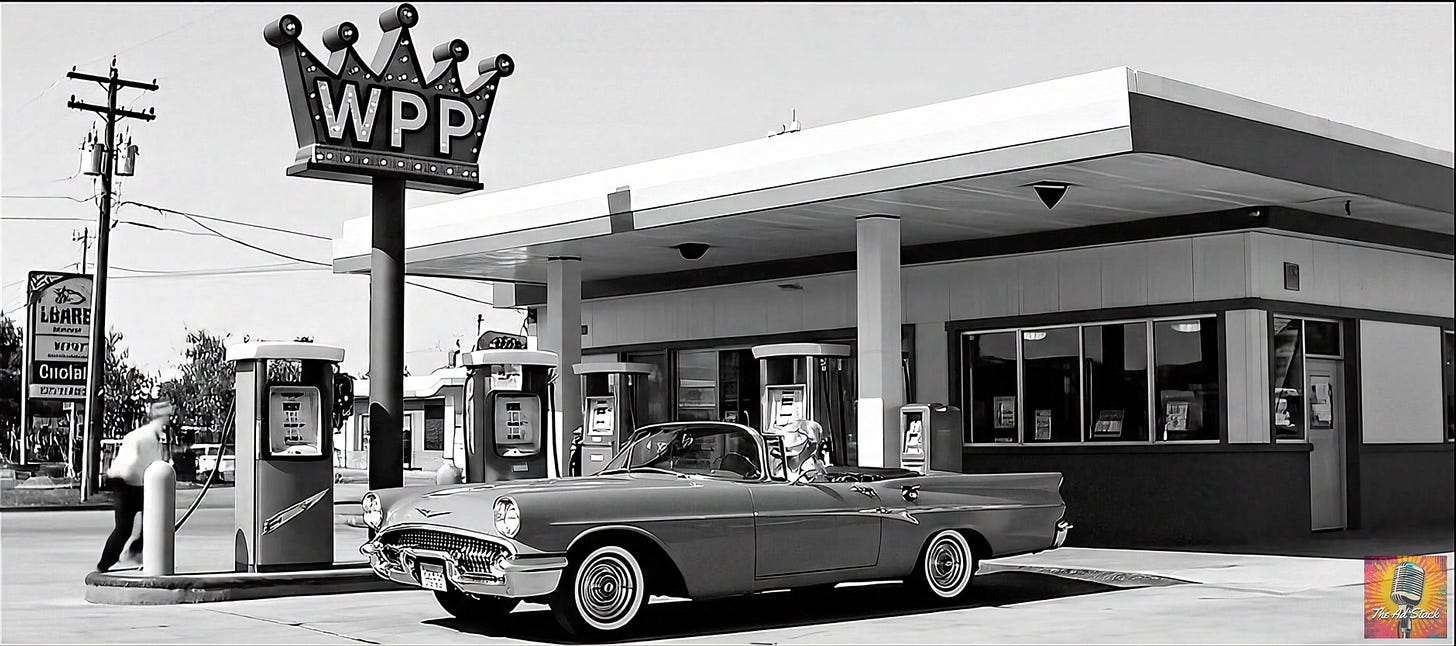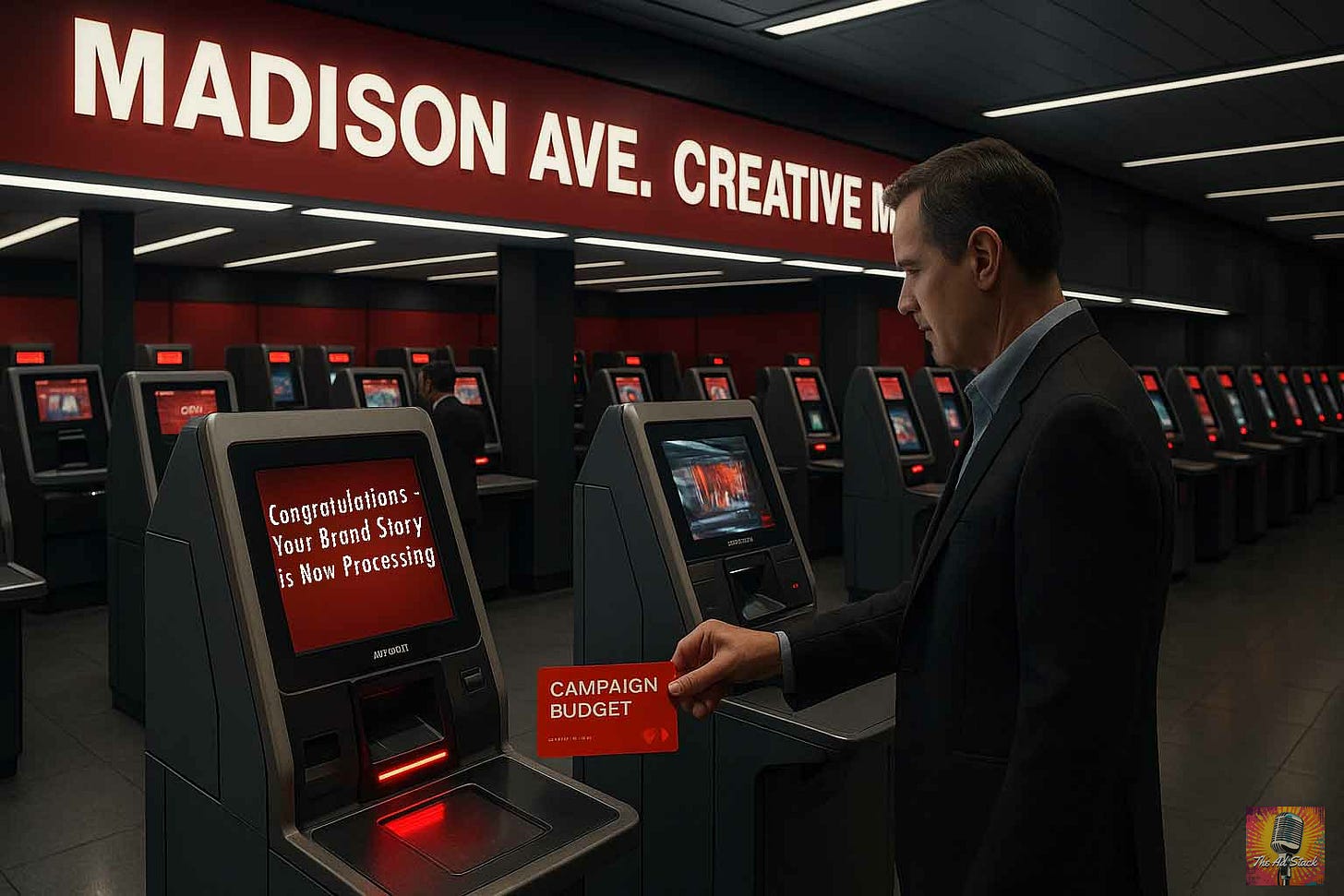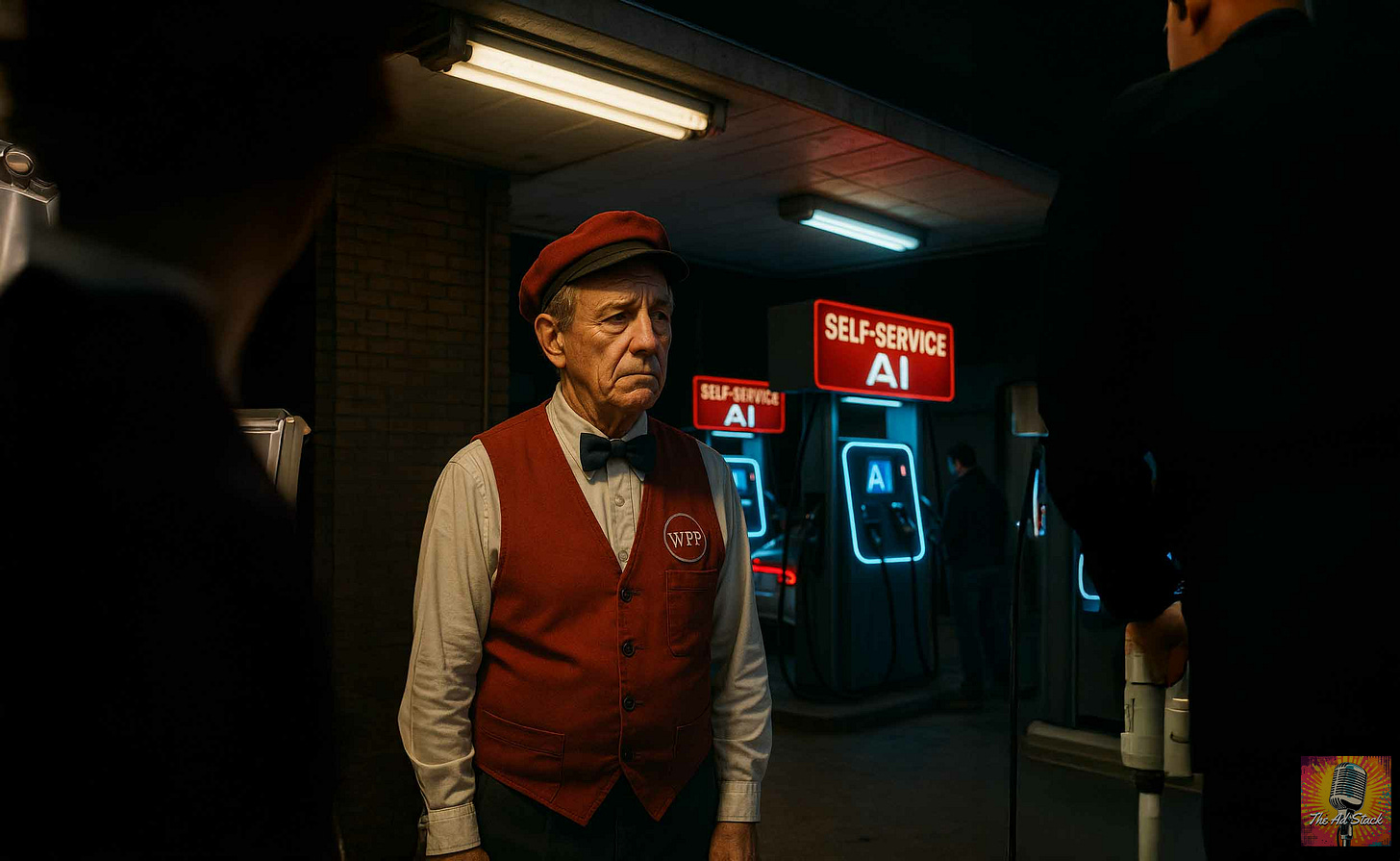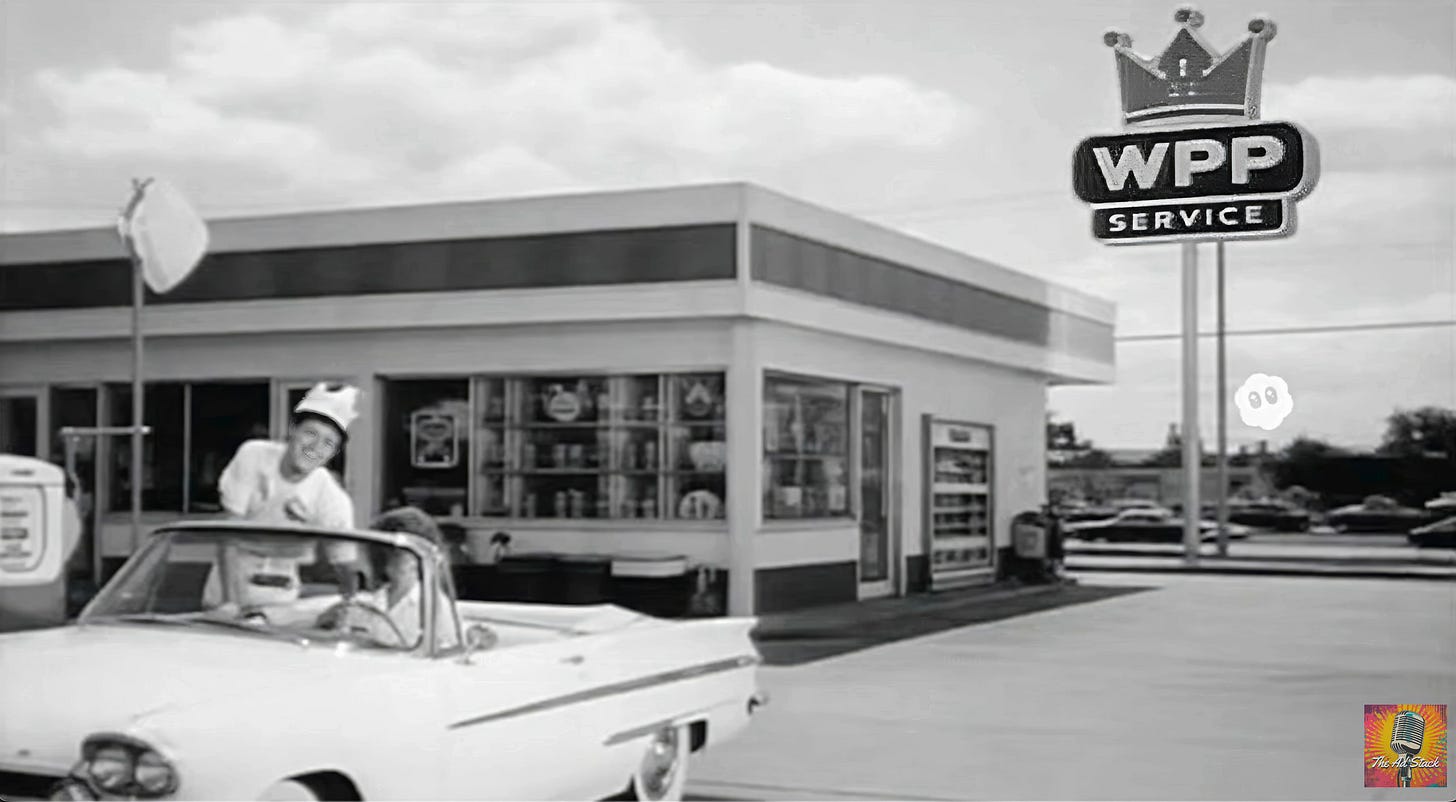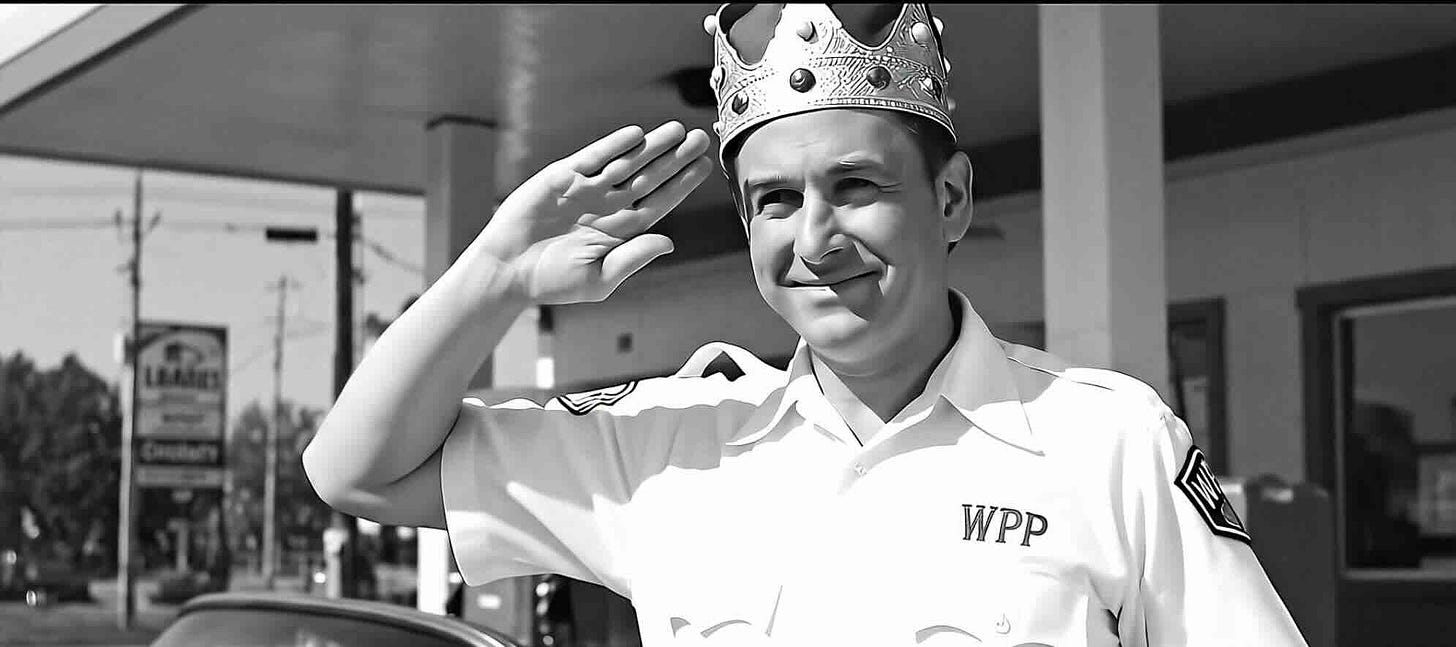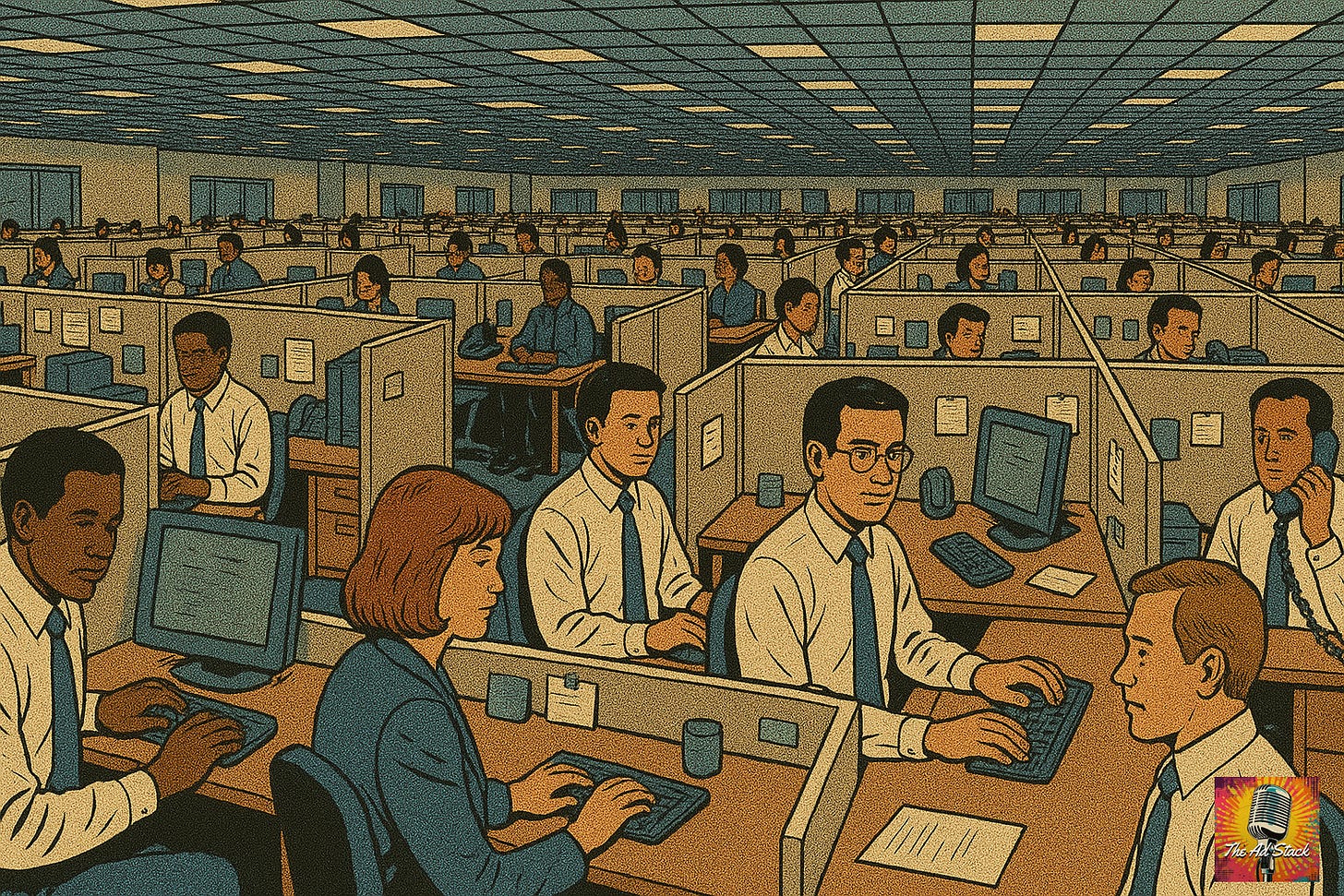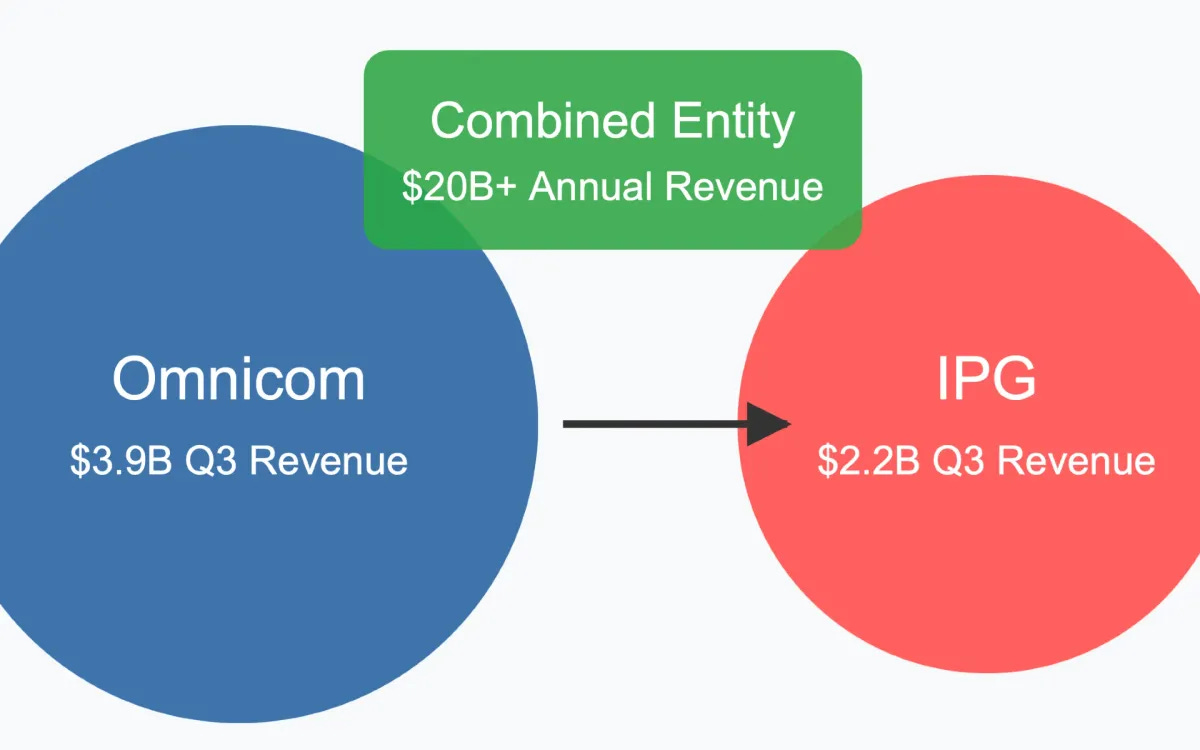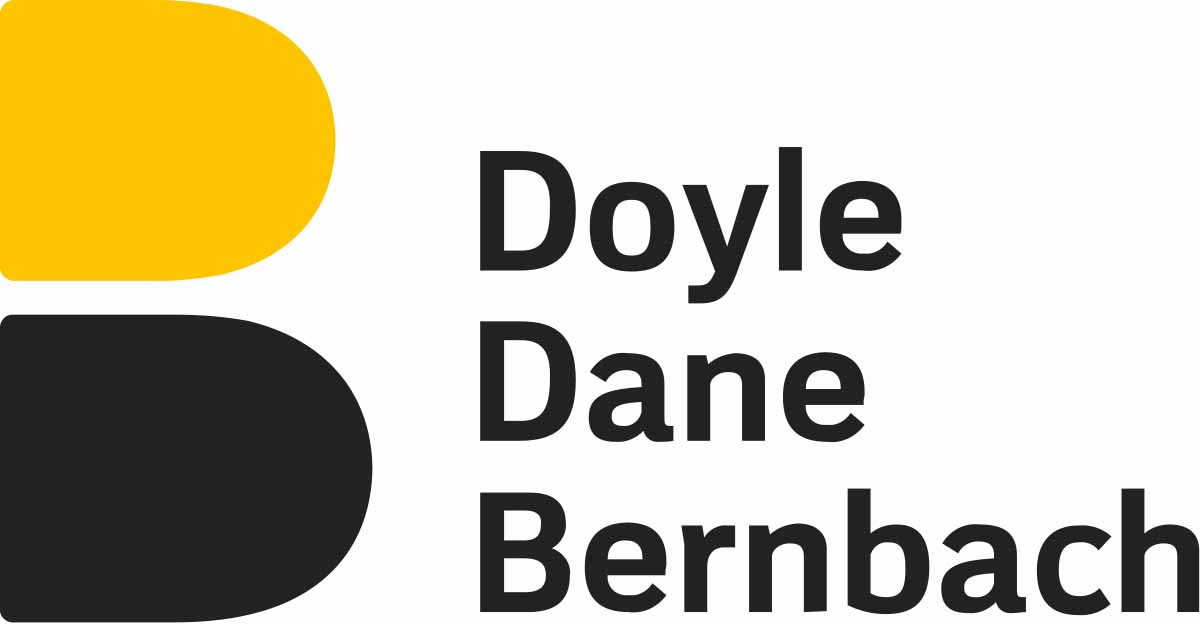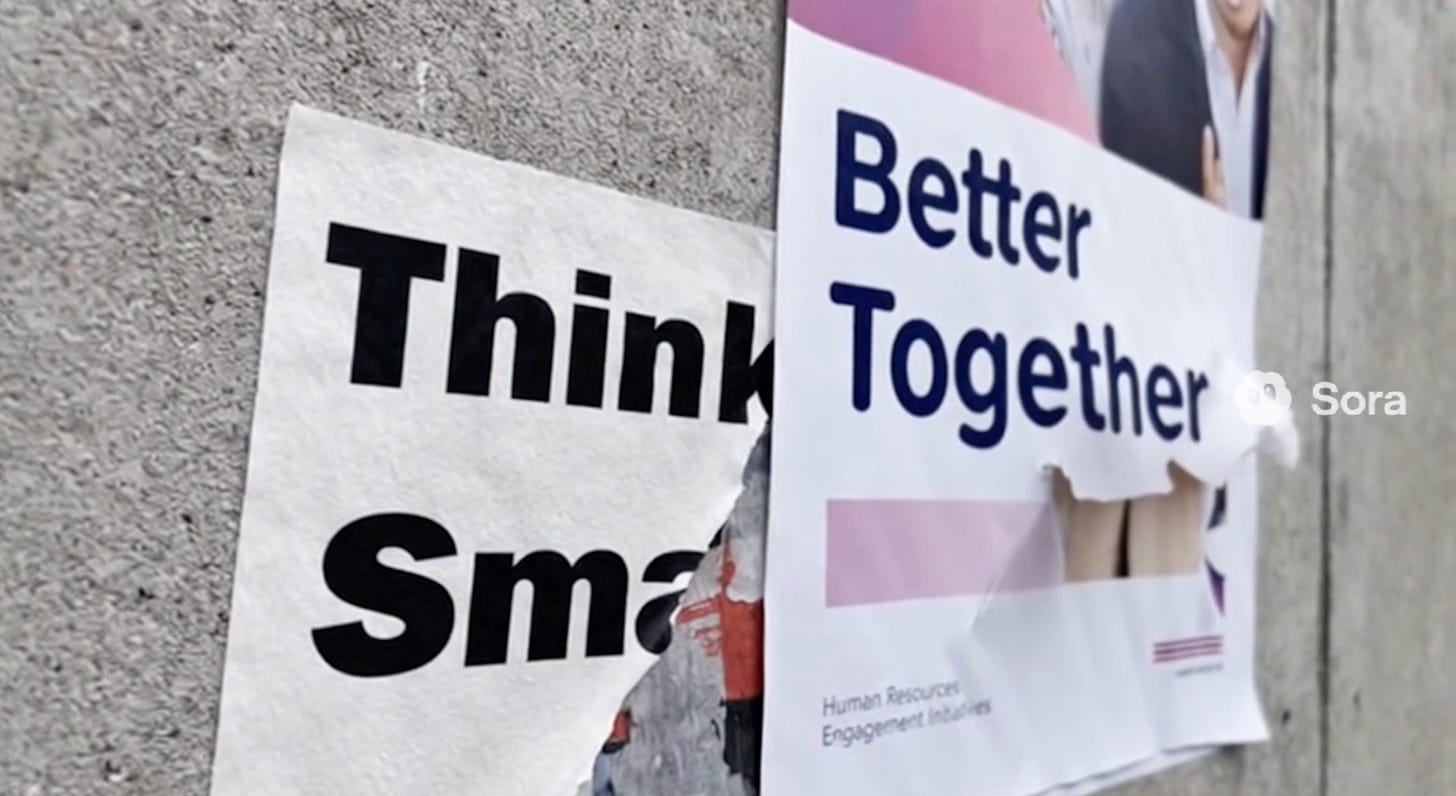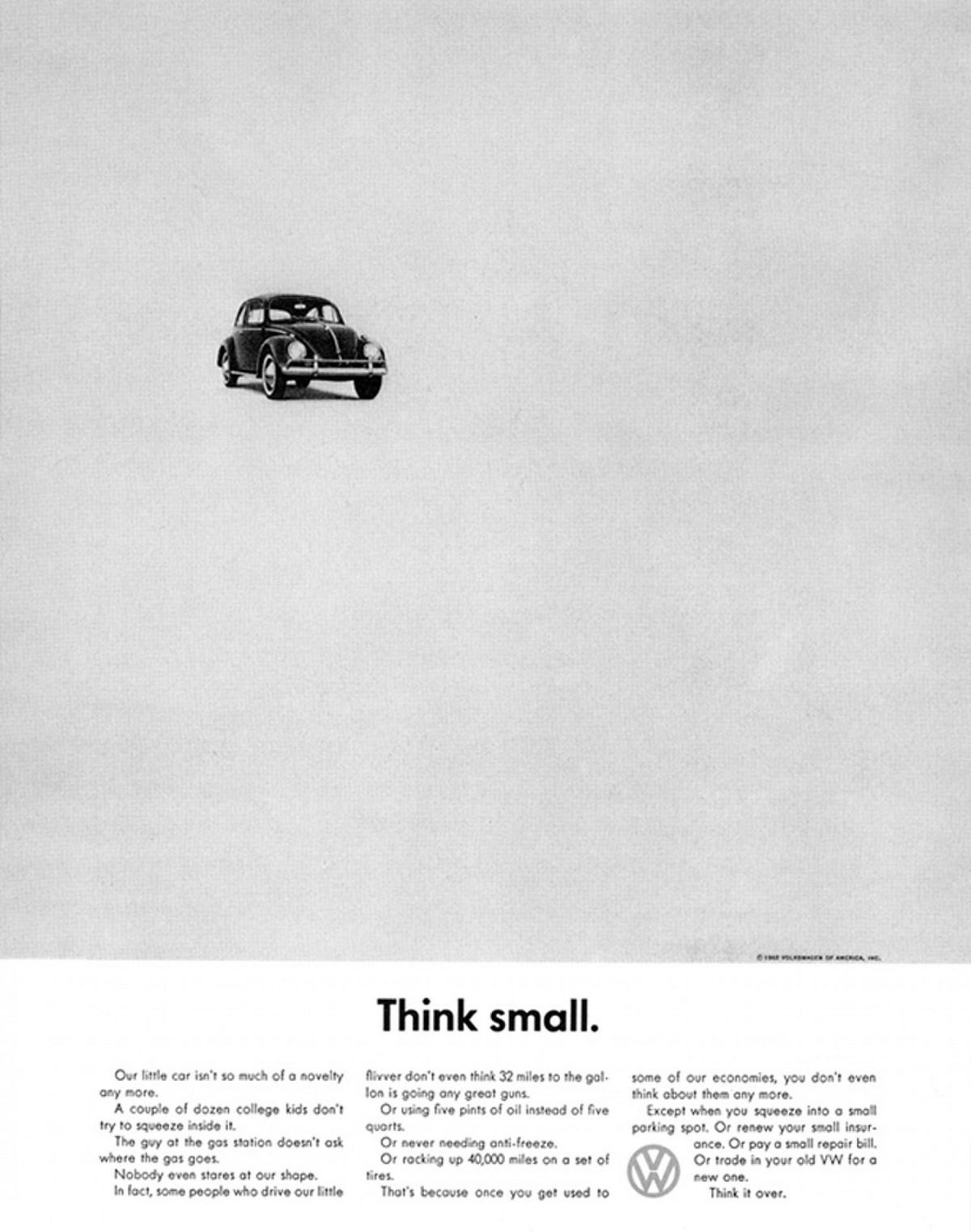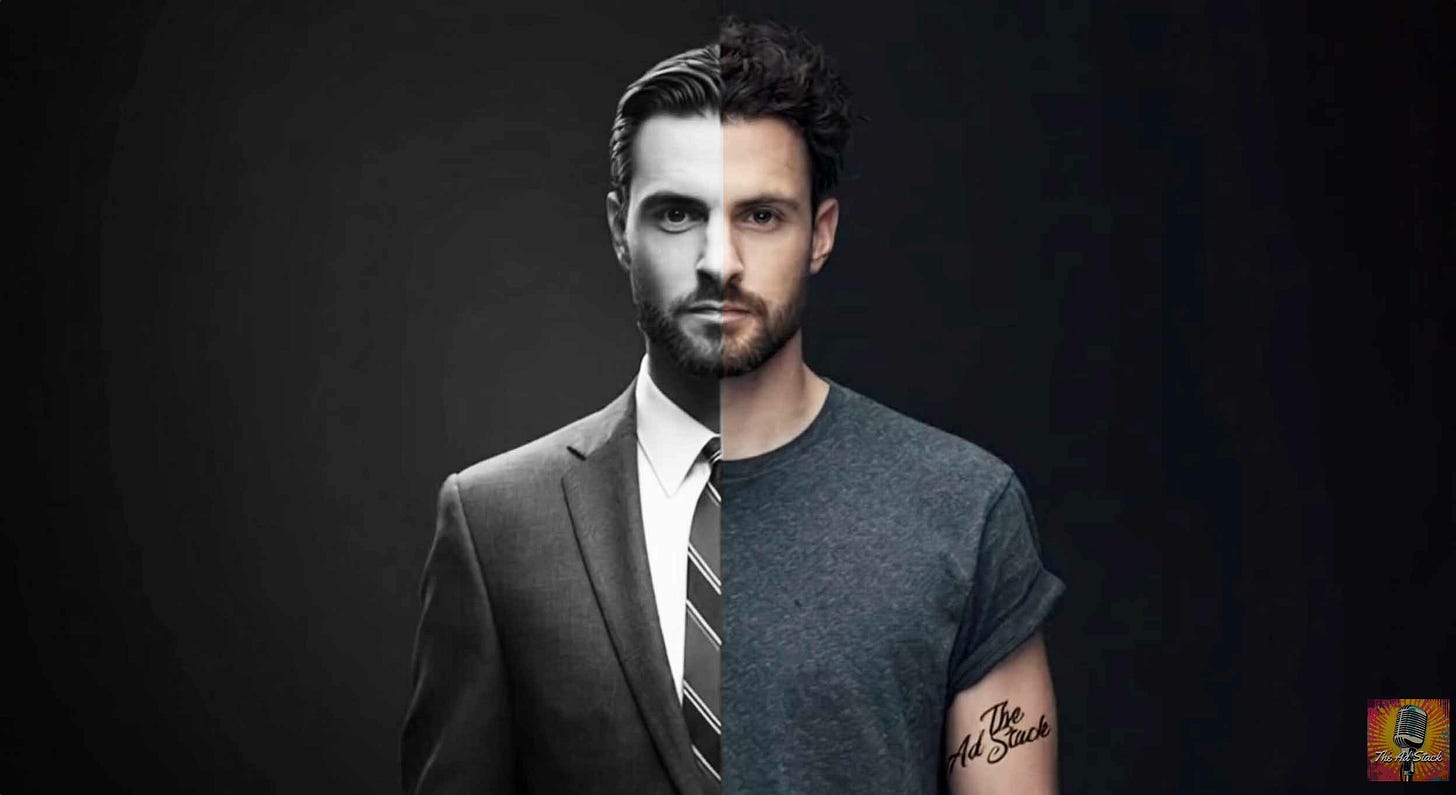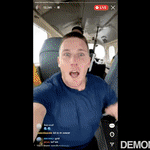Efficiencies. Everything is about efficiencies. Worked with someone who belched that word daily. Regarding most every project. Funny thing, he later “credited” me with his efficient work, looking like … efficient work. But I digress.
Much crazy shizzle happening fast nowadays. Iconic ad brands are dropping like flies. Heyo. Welcome to another edition. WPP goes the way of the automat, and DDB becomes WTF, going bye bye. Simplifies PowerPoint decks. Let’s go.
And all written with satire and sent with love.
Feel free to leave comments and feedback.
“You Can Trust Your Town to that Man Who Wears the Crown.”
WPP was once the unquestioned king of Madison Avenue. That crown is gone. In fact, the firm lost its #1 status after rival Publicis Groupe began out-billing it and snatching net new business while WPP was shrinking. WPP’s organic revenue dropped 1% in its most recent year, with the outlook for 2025 set at flat to down 2%. Meanwhile, global ad-spend growth is decelerating, clients are shunning full-service agencies, and technology-led competitors (and in-house platforms) are nibbling away at agency margins.
So WPP is pivoting almost like a full-service gas station converting to self-service overnight, while the petrol price stays the same and the number of attendants declines. The holding company is rushing to empower clients to pump their own ads via its new platform. That move is called WPP Open Pro. Self-service, AI-enabled, direct-to-brand.
Why Are They Doing This?
To expand its addressable market, WPP is now targeting smaller brands and business units that can’t afford the full-service agency model or are being ignored.
To counter margin pressure: with large clients demanding faster, cheaper work and holding onto tighter internal teams, traditional retainers aren’t cutting it. The self-serve model allows WPP to serve clients with fewer human hours and more tech leverage. Like telling the driver, “Pump your own gas,” so we don’t pay the mechanic anymore.
To stay relevant amid AI disruption, WPP is pouring money into tech (≈ £300 million/year; $399 million USD) and repositioning itself as a “technology-led” agency rather than just a creative factory.
To simplify and integrate: They’ve rebranded their media arm WPP Media, making clear that media + data + production will all run off the same digital rails.
The Risk-and-Reward for WPP
Reward: If successful, WPP opens up new growth from thousands of smaller clients and reduces the cost of delivery per client (less hands-on service). It positions them for the “AI era” in marketing.
Risk: By enabling self-service, WPP may cannibalize its full-service business model. The station that told you, “We’ll service your car,” now says, “You can do it yourself” with the same price tag. So the fear among execs is that the human premium evaporates. Also, if clients see agencies as mere platforms, they may shop around or develop their own in-house stack.
Yes, the holding company that once thrived on complex client retainers and human-powered storytelling has decided that the future of marketing lies in letting clients do it themselves. Plan, create, and publish ads without ever talking to, you know, an ad agency.
The Why: Spoiler, It’s About the Money
WPP’s numbers tell the story nobody wants to pitch:
Organic revenue down 1%, forecasts flat to negative for 2025.
Publicis Groupe has overtaken them.
Hedge funds are circling.
The “creative capital of the world” is now the CFO’s spreadsheet.
When profits fall 71% in a year, it’s not “innovation,” it’s survival. So WPP’s logic goes like this:
“We can’t afford to service every car that pulls in — but what if we sold them the pump?”
Hence, Open Pro — the new self-serve AI station for marketing.
The Process: How to Pump Your Own Creativity
So how will this all work?
Plan – Brands log into WPP Open Pro and feed the system data: product details, audience insights, and budget parameters. The AI “agents” (yes, that’s the actual branding) crunch this into campaign strategies; audience segments, message maps, competitive landscapes.
Create – The same system uses a cocktail of text, image, and video models. Think OpenAI, Google Veo, and Adobe Firefly to generate brand assets. Logos, taglines, storyboards, and even finished video. It’s like briefing your agency … if your agency were a prompt window.
Publish – Finished assets flow directly into ad platforms or WPP’s own media studio. One click, and your AI-built campaign is live. No creative review meetings. No revisions. No pesky producers in the way. And no “let’s circle back Monday.”
In theory, this lets brands produce more content faster. In practice, it’s the beginning of the great automation of advertising. To anyone who’s worked in production, such as myself, it sounds like a staffing reduction wrapped in a UX demo.
The Irony: Disruption by Design
The irony, of course, is exquisite. The very company that invented the agency ecosystem: bundling creativity, media, and data into one package, is now unbundling itself in real-time.
WPP once sold the value of craft, expertise, and partnership. Now it’s selling an interface. It’s as if Firestone stopped making tires and started selling tire-making kits.
The company insists this is the future: “a hybrid model where clients and agencies co-create at scale.” But beneath the buzzwords, it’s a quiet admission: the old model can’t keep up. Machines have rewritten the economics of creativity.
And like the gas station owners of the 1970s, WPP’s executives are trying to convince customers that pumping your own is as great as rolling your own.
The Stakes: The Last Full-Service Station on Madison Avenue
Make no mistake; this is an existential bet. If Open Pro succeeds, WPP becomes the Amazon Web Services of advertising: a platform that powers thousands of smaller brands, taking a small cut of every campaign produced.
If it fails, it becomes the Blockbuster of the ad world: the company that saw Netflix coming and decided to double down on late fees.
The self-serve model is seductive to investors but treacherous for the business. Once brands learn to “do it themselves,” what stops them from doing it somewhere else? Google, Meta, Adobe, OpenAI. They’re all racing to own that same button that says “Generate Campaign.”
And let’s be real: when everyone has access to the same AI tools, differentiation dies. The result isn’t creative empowerment. It’s creative entropy. A thousand ads generated, none remembered.
The Doom Behind the Bloom
The danger? When you hand clients the keys to the gas pump, they eventually stop calling you to fill the tank. WPP Open Pro could end up cannibalizing the very agencies it was meant to modernize. The human premium: strategy, taste, and intuition becomes a subscription tier.
It’s the same logic that gutted service stations in the ‘70s oil crisis: rising costs, desperate margins, and a public too distracted to notice they’re doing the work themselves. “Full-service” was too expensive, so we taught people to squeeze their own handles.
Now, the world’s largest ad conglomerate is teaching clients to squeeze prompts instead.
The Punchline: Welcome to Pump-Your-Own Advertising
Ultimately, WPP’s pivot serves as a reflection of the industry itself. Agencies are turning into tech companies. Tech companies are turning into agencies. And the client, the once-coddled “brand partner,” is now just another user in the dashboard.
Full-service dreams are over now. The attendants have gone home. The lights hum faintly over the digital forecourt, and a polite voice from the speaker crackles to life:
“Welcome to WPP Open Pro. Please enter your campaign objectives.
Payment is contactless. Tips are optional.”
We’re officially living in the era of Do-It-Yourself Madison Avenue. Where creative empires fall not with a scandal or a slogan, but with an automated prompt.
“Optimizing your campaign… please wait.”
If this works, WPP reinvents itself as the world’s biggest creative platform; half agency, half API.
If it doesn’t, well … the next press release will probably come from PublicisGPT.
Bibliography / Sources
WPP plc. 2025 Interim Results. London: WPP plc. 7-Aug-2025. PDF. WPP+1
WPP plc. “WPP Media launches as fully integrated, AI-powered media company.” Press release. 29-May-2025. WPP+1
Reuters. “WPP cuts out the agency to help brands create their own ads with AI.” 23-Oct-2025. Reuters
Financial Times. “WPP halves dividend and announces strategic review as profits sink.” 7-Aug-2025. ft.com
The Guardian. “WPP profits dive 71% as clients cut ad-spending amid tariffs.” 7-Aug-2025. The Guardian
Campaign ME. “WPP Media expands Open Intelligence, reveals retail and media partners.” 6-Jun-2025. Campaign Middle East
MarketingDive. “WPP Media launches AI-driven tool to push beyond ID-based targeting.” (date ~2025) Marketing Dive
Investegate (RNS Announcement). “Chief Executive Officer Succession – WPP plc.” 9-Jun-2025. investegate.co.uk
Cube Chronicles - WPP Edition
💥 Employee comments - The Fish Bowls
1. “We’re training the thing that replaces us.”
”A lot of creative and production folks are grumbling that they’re being told to upload work into WPP Open’s training datasets — without clarity on whether the system is designed to reduce headcount. The sentiment is basically: ‘We’re building the automation layer that will make our jobs redundant.’”
2. “Clients don’t want to pay for beta testing.”
”Producers and account managers say clients are confused by the self-serve messaging; why pay WPP when the pitch is “you can do it yourself”? It’s creating awkward sales conversations, especially in mid-tier markets.”
3. Not all doom and gloom, though.
“Some strategists and data leads see WPP Open Pro as a competitive moat, a way to keep smaller clients inside the ecosystem instead of losing them to Canva + ChatGPT + Freelancers.”
“A few tech-savvy teams are calling it ‘finally a usable tool’ after years of fragmented WPP systems.”
The Brand in the Crosshairs?
The great crumble has begun.
Once upon a time, giant ad networks—halls full of creatives, espresso machines humming, PowerPoints full of Pentagrams of Innovation—now resemble a zombie-movie set: desks still there, chairs askew, middle-management spirits wandering aimlessly. At the center of this apocalypse? DDB. Except “at the center” is wrong: more like “on the chopping block”.
According to multiple leaks, whispers, and Reuters-esque bulletins, the Omnicom Group and Interpublic Group merger (a monstrous $13.5 billion beast) is poised to gobble up agency brands in a consolidation frenzy so sweeping it makes re-org on steroids look tame.
DDB
Word is: the network may be dissolved, absorbed, or re-branded into something with fewer sparkles and more spreadsheets.
Remember when DDB was supposed to stand for “Doyle Dane Bernbach?” The creative revolution, the Weiner-sandwich of art and attitude, the agency where “Think Small” became gospel? Now it looks like they’re being told to think even smaller: think “merge & cut”. The message from the top: creativity is expensive, synergy is cheap. One Reddit commenter nailed the tone:
“If they do merge, it’s not for creativity … it’s for consolidation and survival. Big holding companies aren’t innovating, they’re merging decks and firing mid-tier talent to fluff stock prices.”
Consolidation and Survival
Enter a brave new world where three global networks will stand tall. DDB might not be one of them. The rumor mill says only two or three agencies will survive the re-architecting of the holding company empire, meaning legacies will drown in PowerPoint and restructure memos.
And for the creatives, suits, producers, freelancers, and production partners? Time to catch your breath. Because the way the writing’s on the wall, the next 12-24 months are going to look like Halloween every day: dark hallways, branded posters ripped down, desks repurposed as “temporary hot spots”, conference rooms turned into “integration pods”, and freelancers getting calls from “procurement” instead of “creative strategy”. The umbrella brand is over: “agency” now means “service provider to holding company strategy”. The fight is not just for accounts. It’s for existence.
Margin Matters
In the midst of all this, the irony is thick. One of the most “creative” industries is now running headlong into a world that rewards efficiency, scale, and standardization over spark. Margin matters. Global reach matters. Legacy culture? Not so much. DDB’s recent history, from being a creative beacon to now being reportedly undermined, told to justify its existence, is telling.
They may say “new era,” “unified offering,” “better together,” but really it means: “Brand you loved? Sorry, we’re reducing the brand names you love.”
So for The Ad Stack audience: producers, agency lifers, permalancers, and creators who’ve seen it all, here’s your survival aide-memoir:
Expect restructure, not reinvention.
The mega-mergers aren’t about radical creative rebirth; they’re about efficiency. One article puts it: “There isn’t as much money (for holding companies anyway) in creative any more and cost cuts (job losses) are part of the sell to Wall Street.”Brand names will fade, networks will absorb.
DDB might vanish or get re-skinned. It might live on in some boutique form, but the global powerhouse? Probably not as you used to know it.Freelancers and production folks: your network is about to shift.
Agencies will centralize; expect fewer legacy contacts, more CPO/COO-type buyers; margins may shrink; service delivery becomes bigger than creative novelty (doing the work, and meeting the promise should matter more than the new, fancy, showy idea).
The satire practically writes itself: the glorious agency that rode the “creative edge” wave now brushes dust while the holding company consolidates, cuts costs, and says, “Let’s unify operations globally.”
Opportunity Still Lurks
In any collapse, new niches emerge: agile boutique agencies, internal client teams, consultancy-style creative houses. If the giants are collapsing, smart smaller players grab the debris. For our audience of producers worried about job security: yes, it’s scary, but also a chance to reposition.
Let’s wrap this up: if DDB fades (or is absorbed), it won’t feel like a quiet curtain call. It’ll feel like a blockbuster sequel gone direct to streaming. All excitement, then you check your watch and realize you’ve been edited out. Creative staff will shuffle, clients will shift, brand heritage will get glossed over in “transformation messaging.” Holding companies will pat each other on the back for “synergies unlocked,” while a VP of Prompt Engineering in a mid-town Chicago cubicle farm wonders where the Nespresso machine with the organic brand disappeared to.
So raise a film-production-grade espresso to the fallen giants. Because the ad-agency game as we once knew it is getting shelved, archived, perhaps turned into “case study” rather than “frontline culture.”
Bibliography of Sources
“Omnicom to retire iconic DDB brand following IPG merger: report.” Storyboard18, Oct 29 2025. Storyboard18.
“Omnicom–IPG merger: DDB to integrate into TBWA?” Exchange4Media, Oct 29 2025. Exchange4Media
“Report: DDB Brand Set To Retire As Part Of Omnicom’s IPG Acquisition.” B&T, Oct 29 2025. B&T
“Reports Suggest, DDB May Be Dissolved as Part of Omnicom–IPG Merger.” ImpactOnNet, 2025. Impact On Net
“Which IPG shops are likely to survive the ‘merge’?” Reddit discussion, Advertising subreddit. Reddit
“DDB Worldwide.” Wikipedia. (Accessed 2025) Wikipedia
“Omnicom Group.” Wikipedia. (Accessed 2025) Wikipedia
Before you go ...
Please forward this to three total strangers, co-workers, and someone you cannot stand.
Like and Re-stack it below so others can find it!
Drop a comment below. If you’re into it, if it sucks … perhaps drop a Haiku about programmatic AI. Your call.
Thanks for the read!


